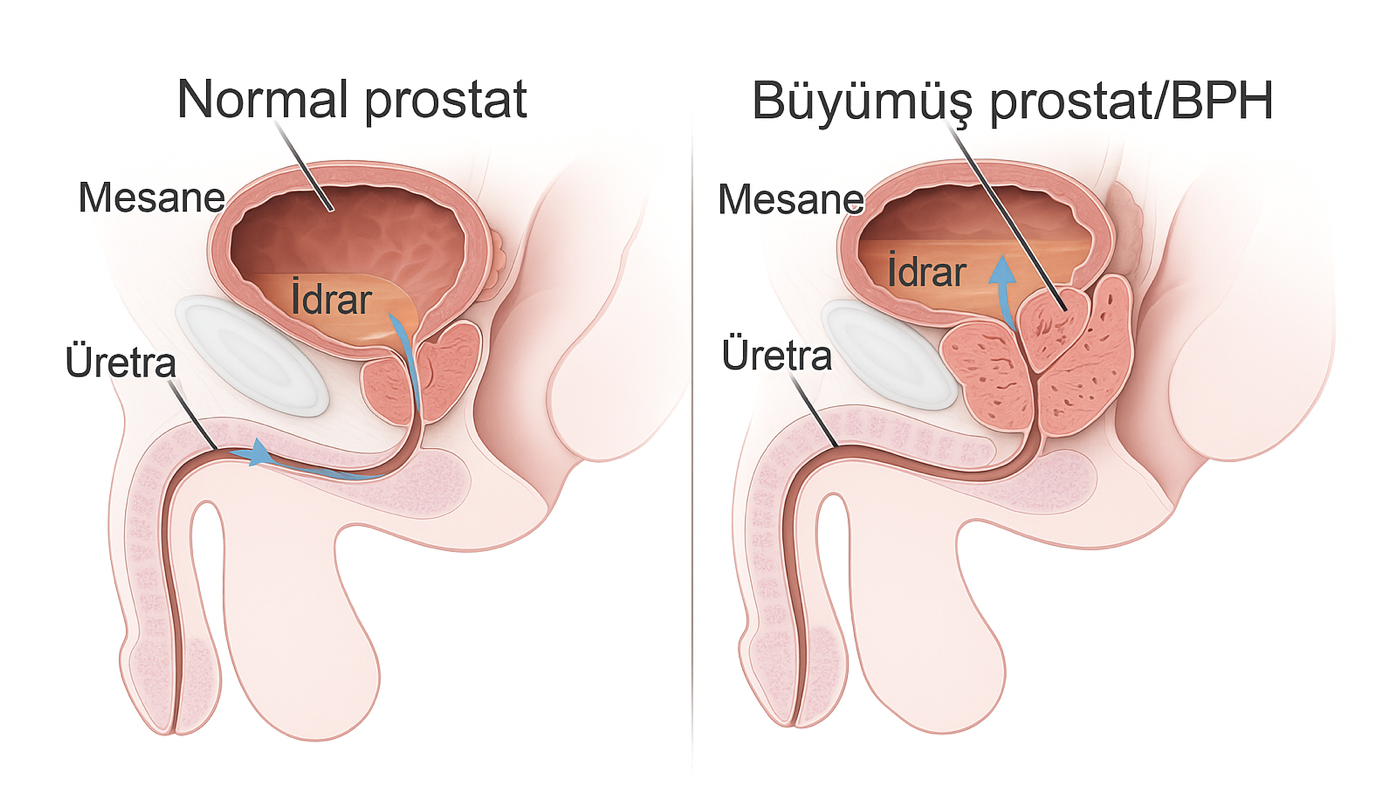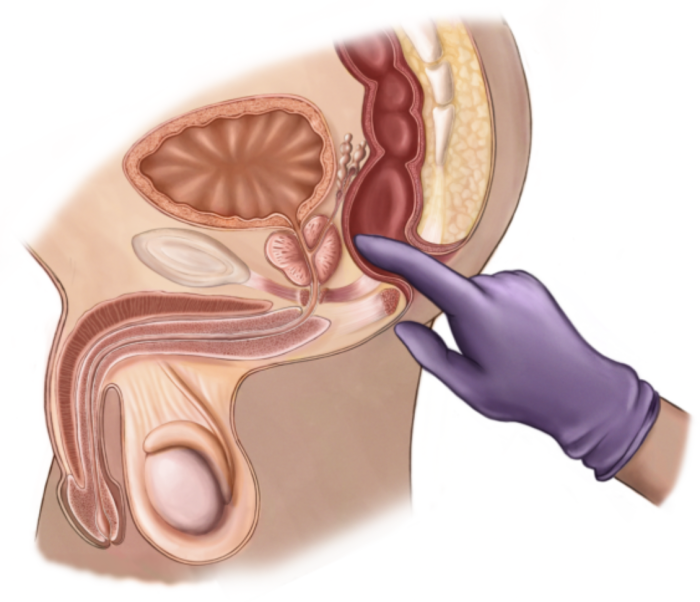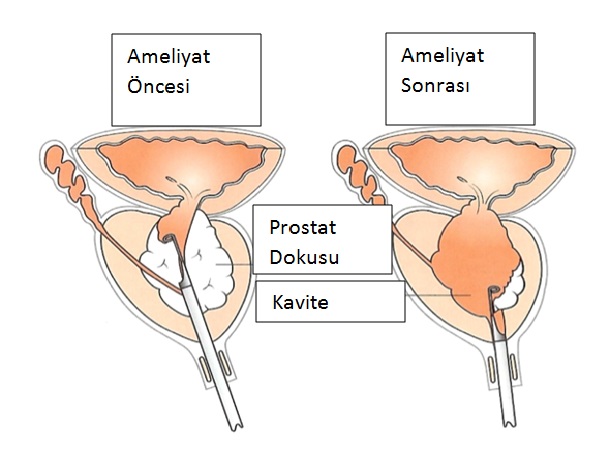Benign Prostatic Hyperplasia (BPH)

What is benign prostatic hyperplasia (BPH)?
BPH refers to the enlargement of the prostate. The prostate is normally the size of a walnut but can grow to the size of an orange over time. The prostate undergoes two main growth periods during a man's lifetime:
- The first occurs during puberty, when the prostate doubles in size.
- The second begins around age 25 and continues to grow slowly for the rest of a man's life.
If you have been diagnosed with benign prostatic hyperplasia (BPH), you are not alone.
BPH is a common condition in men as they age. In fact, approximately half of men between the ages of 51 and 60 have BPH. In men over the age of 80, this rate rises to 90%.
Does BPH Require Treatment?
BPH may not require treatment on its own, but treatment is necessary if symptoms arise.
BPH Is Not Cancer.
This means it is not cancer and does not cause cancer. However, BPH and cancer can occur at the same time. If you have symptoms, a prostate biopsy may be necessary to determine whether the condition is benign or cancerous.
Who is at risk for BPH?
- Men over the age of 50 (the risk of BPH increases with age)
- Men with a father who has BPH
- Overweight or obese men
- Men who are inactive (lead a sedentary lifestyle)
- Men with certain erectile dysfunction (ED)
What are the symptoms of BPH?
- Incomplete emptying: The feeling that your bladder is not completely empty even after urinating.
- Frequency: The need to urinate once or twice an hour.
- Intermittent: The need to stop and start again several times while urinating.
- Urgent Urination: The sudden and unexpected urge to urinate.
- Weak Urine Flow: A condition where the urine flow is weak and forceful.
- Difficulty: Difficulty starting to urinate or the need to strain to urinate.
- Nocturia: The need to urinate more than twice during the night.
Don't delay, let's meet now !
- Feneryolu Bagdat Avenue No 85/1 Postal Code: 34724 Kadıköy/İstanbul - Turkey
What Are the Causes of BPH?
The causes of BPH (Benign Prostatic Hyperplasia) are not fully understood. It usually occurs in older men. Hormonal changes are thought to play a role in this process. Hormones secreted by the testicles are considered the main factor.
For example, as men age, the amount of active testosterone in the blood decreases. In contrast, estrogen levels remain constant. These hormonal changes may trigger the growth of prostate cells and lead to BPH.

Tests Used to Diagnose BPH
1. Digital rectal exam
A rectal exam is usually an important part of a prostate exam. During this exam, you will be asked to lie on your side or bend forward. The doctor inserts a gloved and lubricated finger into your rectum to feel the back wall of the prostate. This brief (10–15 seconds) examination is important for detecting abnormalities such as enlargement, tenderness, lumps, or hardness.

Urinalysis and Imaging Tests
Some imaging methods used in the diagnosis of BPH include:
- Ultrasound: Used to visualize the inside of the body and assess the size and shape of the prostate.
- Cystoscopy: This procedure involves examining the urethra (urinary tract) and bladder using an endoscope.
- Magnetic Resonance Imaging (MRI) and Computed Tomography (CT): Used to obtain more detailed images in cases requiring surgery. These methods clearly show how and where the prostate is growing.
Urinalysis:
These tests are performed to assess whether there is an infection, blood in the urine, and whether the urine flow is normal:
- Urine Analysis: A urine sample is collected to check for blood, signs of infection, glucose (sugar), protein, and other factors. A bladder cancer screening may also be performed. If there is blood in the urine, burning, or difficulty urinating, a specialist should be consulted immediately.
- Post-void Residual Volume (PVR): This test measures the amount of urine remaining in the bladder after urination. It is used to monitor the diagnosis and treatment of BPH.
- Uroflowmetry: Measures how fast urine flows. Used to monitor the diagnosis and treatment of BPH.
- Urodynamic Pressure Flow Study: Measures bladder pressure during urination. Used in some specific cases for preoperative evaluation.
Blood Tests
- Prostate-Specific Antigen (PSA) Test: Used for prostate cancer screening. The PSA test measures the level of a substance called benzamine in the blood, which is produced only by the prostate. It plays an important role in the diagnosis of prostate cancer. Avoiding sexual activity for a few days before the test prevents the PSA level from rising artificially.
- In a healthy prostate, PSA levels in the blood are very low. Sudden increases in PSA levels may indicate a problem.
- Benign prostatic hyperplasia (BPH) and prostatitis can also increase PSA levels. However, the most serious cause is prostate cancer.
Treatment Options
There are many treatment options available for BPH (benign prostatic hyperplasia). The treatment method you and your healthcare professional choose will be determined based on the severity of your condition, the severity of your symptoms, and your quality of life. While treatment may not be necessary in mild cases, medication may be sufficient in some cases. In some cases, surgical procedures may be necessary.
BPH Treatment Methods:
- Active Monitoring
- Prescription Medications
- Less Invasive Surgical Methods
- More Invasive Surgical Methods
1️⃣ Active Monitoring
In cases where BPH causes mild or moderate symptoms, monitoring alone may be sufficient. This method involves regular urology check-ups to monitor growth. Annual examinations are generally recommended. During this process, your healthcare professional will check for any worsening of symptoms or the emergence of new problems.
- Diet and Exercise: A healthy diet and regular exercise play an important role in controlling symptoms and preventing them from worsening.
- Who is it suitable for? Men with mild to moderate symptoms who are not bothered by their symptoms.
2-️⃣ s Prescription Medications
Alpha Blockers
- Relaxes the smooth muscles in the prostate and bladder, thereby relaxing the canal and facilitating urine flow.
- They do not shrink the prostate but improve urine flow by reducing blockage.
- Benefit: Works quickly.
- Side Effects: Dizziness, low blood pressure upon standing, feeling weak, fatigue, and inability to fully empty the bladder.
- Who is it suitable for? Men with moderate to severe BPH symptoms.
5-Alpha Reductase Inhibitors
- It inhibits DHT (dihydrotestosterone) production, thereby reducing prostate size.
- It may reduce problems associated with BPH and the need for surgery.
- Side effects: Erectile dysfunction and decreased libido (sexual desire).
- Note: Medications may require long-term use to be effective.
Combination Therapies
- The use of alpha blockers and 5-alpha reductase inhibitors together.
- Both types of medications may be more effective when used together.
- Side Effects: Dizziness, erectile dysfunction, fatigue, and low blood pressure upon standing.
- Recommended Combinations:
- Finasteride + Doxazosin
- Dutasteride + Tamsulosin
- Alpha Blockers + Antimuscarinics
Antimuscarinics:
- Used in patients with symptoms of an overactive bladder.
- Relaxes bladder muscles and reduces the urge to urinate frequently.
- Who is it suitable for? Men with overactive bladder and enlarged prostate.
Phytotherapies and Herbal Treatments:
- Not generally recommended by health professionals.
Although herbal supplements such as Saw Palmetto are popular, many studies have shown them to be ineffective.
3️⃣ Minimally invasive surgical procedures (MIST)
Minimally invasive surgical procedures (MIST) can be performed without hospitalization and have a very short recovery time. These methods generally improve urine flow, but may require repeat treatment.
Good Candidates:
- Patients who do not respond to medication
- Weak urine flow
- Difficulty urinating
- Urinary tract obstruction, bladder stones, or blood in the urine
- Inability to fully empty the bladder

Prostate Urethral Lifting (PUL):
- Small implants are placed to compress the prostate tissue and relieve pressure on the urethra.
- These implants are permanent and cannot be removed.
- Advantage: Sexual side effects are minimal, and no surgical incision is required.
- Who is it suitable for? Patients with an enlarged prostate who do not wish to undergo surgery.
Thermal Therapy with Water Vapor (Rezum):
- Reduction and elimination of prostate cells using steam (steam energy)
- Can be performed in a clinic under local anesthesia.
- Recovery Process: Bleeding in urine and frequent urination decrease within 2-3 weeks.
- Sexual Side Effects: Rarely observed.
- Who is it suitable for? Patients who have not responded to medication and do not wish to undergo surgery or are at high risk for surgery.
Prostate Artery Embolization (PAE):
- A procedure performed by radiologists to reduce the size of the prostate by blocking its blood supply.
- Short-Term Effects: Temporarily improves urine flow, but long-term data is limited.
4️⃣ More Invasive Surgical Methods
In cases where BPH is severe or other treatment methods have failed, more invasive surgical procedures are recommended. These surgical methods relieve severe blockages and restore urine flow.
Conditions Requiring Surgical Intervention:
- Inability to urinate (complete obstruction)
- Kidney damage
- Frequent urinary tract infections
- Severe bleeding
- Bladder stone formation
- Patients who do not respond to medication
Invasive Surgical Options:
Transurethral Prostate Incision (TUIP):
- Preferred in patients with small prostates where the prostate gland causes severe obstruction.
- Small incisions are made in the bladder neck and prostate tissue to widen the canal.
- These incisions widen the urethra, alleviating urinary flow.
- Hospital Stay: 1–3 days.
- Catheter Use: A urinary catheter is kept in place for 1-3 days after surgery.
- Who is it suitable for? Patients who do not want a complete prostate removal but are experiencing severe obstruction.
Photoselective Vaporization (Greenlight):
- Prostate tissue is vaporized using a high-powered laser.
- Advantage: Bleeding is minimal, making it suitable for patients taking blood-thinning medications.
- Recovery Process: Most patients are discharged on the same day.
- Who is it suitable for? Patients with a small prostate and a risk of bleeding.
Transurethral Prostate Resection (TURP):
- The most commonly used surgical method for treating BPH.
- Prostate tissue is cut and removed using an electric current.
- Procedure: A device called a resectoscope is inserted through the urethra, which contains light, fluid flow, and an electrical loop.
- Recovery Process: 1-2 days in the hospital and catheterization to facilitate urination.
- Who is it suitable for? Men experiencing moderate to severe symptoms of BPH.
Holmium Laser Enucleation (HoLEP):
- Using a resectoscope, the prostate tissue is removed through the urethra using a laser.
- Advantages: No incisions are made, and bleeding is minimal.
- Recovery Process: Typically, patients stay in the hospital for one night, and the catheter is removed the next day.
- Who is it suitable for? Patients with a large prostate who prefer less invasive methods.
Thulium Laser Enucleation (ThuLEP):
- A procedure similar to HoLEP but using a different type of laser.
- Advantages: Lower risk of bleeding, no incision, and shorter recovery time.
- Recovery Process: Typically, patients stay in the hospital for one night, and the catheter is removed the next day.
- Who is it suitable for? Patients with an enlarged prostate who are seeking a minimally invasive treatment.
Transurethral Prostate Vaporization (TUVP):
- A procedure where an electric current is used to vaporize prostate tissue through the urethra.
- Advantage: Small blood vessels are sealed, reducing the risk of bleeding.
- Recovery Process: Typically requires an overnight hospital stay, and a catheter is usually not needed.
- Who is it suitable for? Patients with an enlarged prostate who are seeking a less invasive solution.
Transurethral Water Jet Ablation:
- First, ultrasound mapping is performed to identify the target tissue.
- Then, an enlarged prostate tissue is removed using a high-pressure water jet.
- After the procedure, patients stay in the hospital for one night, and a cleansing procedure is performed to prevent blood clots in the bladder.
- The duration of catheterization is determined based on the post-operative prostate volume.
Simple Prostatectomy:
- The enlarged portion of the prostate gland is removed through open, laparoscopic, or robotic surgery.
- These surgeries require significant surgical experience.
- They are most commonly used in patients with very large prostate glands.
- Generally, patients are monitored with a catheter for 5–7 days in the hospital, and activities must be restricted for several weeks after discharge.
- In most patients, symptoms improve significantly after treatment.
- In some patients, retrograde ejaculation (backward flow of semen into the bladder) may occur after surgery.
The most common complications after simple prostatectomy include urinary tract infections, bleeding, incontinence (urinary leakage), and scar tissue formation.
Can prostate enlargement be prevented?
There is no sure way to completely prevent prostate enlargement. However, certain lifestyle changes can reduce the risk and help alleviate symptoms :
Recommended Lifestyle Changes:
1️⃣ Weight Control:
Excess body fat can increase hormone levels, leading to prostate cell growth.
Maintaining a healthy weight is important for prostate health.
2️⃣ Balanced Diet:
A diet rich in fruits, vegetables, and whole grains is recommended.
Certain prostate-friendly foods such as tomatoes, broccoli, pumpkin seeds, and walnuts should be consumed.
Consumption of red meat and foods high in fat should be limited.
3️⃣ Physical Activity:
Regular exercise helps control weight and is beneficial for hormonal balance.
It is recommended to engage in at least two to three hours of moderate exercise (walking, swimming, cycling) per week.
4️⃣ Reducing Alcohol and Caffeine Consumption:
Alcohol and caffeine can increase bladder irritation and worsen symptoms.
5️⃣ Avoid Smoking:
Smoking can negatively affect blood circulation and impair prostate function.
Preventing Prostate Enlargement from Recurring:
After BPH treatment, certain measures can be taken to prevent symptoms from returning or new symptoms from developing:
Medication: After surgery, certain medications may be required to manage symptoms.
Regular Check-ups: Annual urology check-ups should be conducted to monitor prostate enlargement and urinary function.
Lifestyle Continuity: Healthy eating, exercise, and regular fluid intake should be maintained.
Frequent Urination: When you feel the need to urinate, go to the bathroom immediately and avoid keeping the bladder full for extended periods. If these symptoms persist for more than one month after treatment, certain bladder relaxant medications may be used to manage them.
